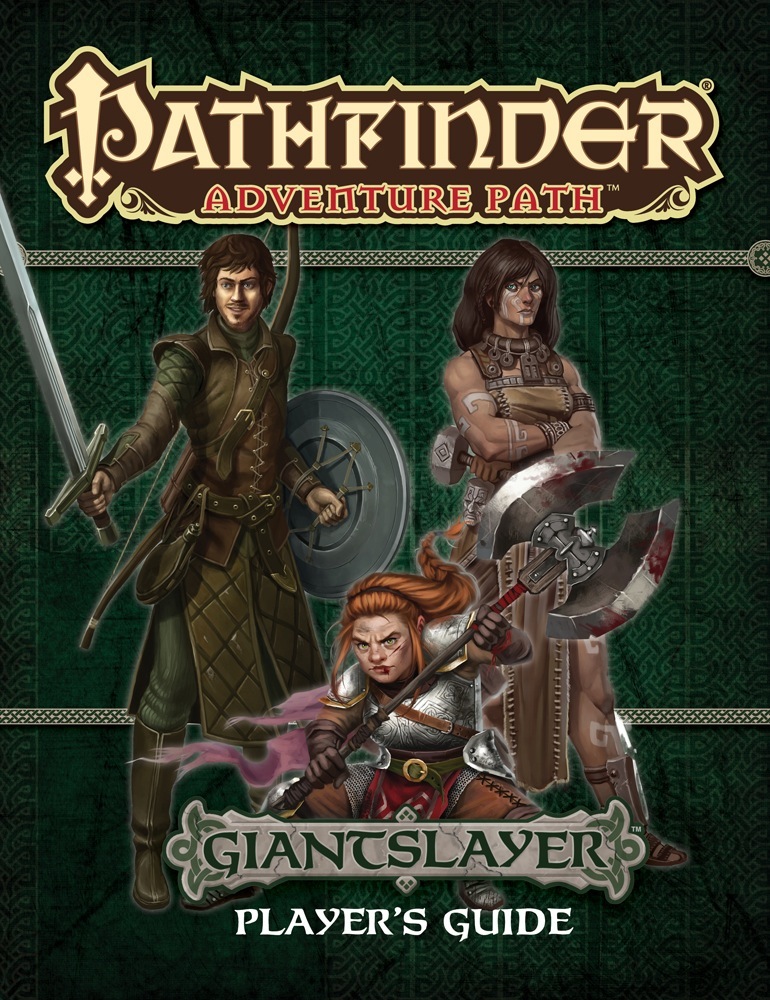In
order to get an adventure path going, the players need characters,
and ideally, they’ll create characters that are suited for the
particular adventure path they’ll be undertaking—characters who
come from the appropriate region(s), and have relevant skills and
abilities. In the case of the Giantslayer Adventure Path, they should come from the town of Trunau in
Belkzen or have a reason for being in Trunau, and they should be
interested in fighting giants.
The
Giantslayer Player’s Guide
provides players with the tools they need to create such characters.
And it does a reasonably good job. One
of the difficulties adventure path player’s guides can encounter is
providing enough information to let players create characters
appropriate to the entire
campaign—not just the opening—while not giving away too much
about later parts of the campaign. In the case of Giantslayer, this
means making it clear that the PCs will be fighting giants (it’s in
the name of the adventure path, so it shouldn’t come as much of a
surprise to the players even though it may be to the characters) and
that they will be travelling through the Mindspin Mountains.
Like
most adventure path player’s guides, the Giantslayer
Player’s Guide opens with a
brief overview of the campaign. This includes some suggestions on how
the characters might already
know or come to know each other. It then moves on to some basic
character tips, including suggested archetypes, animal
companions, bloodlines, favoured enemies, and so on. Since it’s not
mandatory that PCs come from Trunau (although it is strongly
recommended that at least one come from Trunau), it also includes a
section on possible nearby places of origin.
Of
course, one of the most noteworthy parts of any adventure path
player’s guide—and the section many players probably turn to
first—is the section on campaign traits. These are the background
details and minor abilities that fine tune characters to the
particular adventure path. In some adventure paths, the campaign
traits provide the characters an intrinsic tie to the events, making
taking a campaign trait necessary for all characters, as they provide
something important to the story, sometimes even tying into specific
events in the adventure path. In other adventure paths,
the campaign traits are more generalised, offering abilities tailored
to the adventure path, but otherwise being little different from the
other traits players can select at character creation. In the case of
Giantslayer, the campaign traits are of the latter kind, and this
does make them seem a little underwhelming at
first, a little less special.
That isn’t necessarily a fair criticism though, as there isn’t
really anything that requires every adventure path to require PCs who
were born specifically for that adventure path. These campaign traits
are well balanced with other traits (some adventure paths do have
campaign traits that are noticeably more powerful than other traits)
and provide abilities that will be useful throughout the entire
campaign. One nice thing here is that, because they are campaign
traits, players can be reasonably confident that abilities that might
be very situational in other campaigns (such as Artifact Hunter’s
ability to recognise artifacts) will see use in this campaign.
The
bulk of the Giantslayer Player’s Guide,
however, is given over to a gazetteer of Trunau. Given the importance
of the town to the opening of the adventure path, players will likely
be grateful to have this information at their fingertips. One thing I
really like about this section is that, as well as giving
site-by-site descriptions of the town, it also provides fairly
extensive background on what life is like in Trunau. Given its
location in an orc-dominated country, Trunau society has developed
some very specific customs, and the gazetteer allows players some
idea of what it’s like to live there. It gives them information
that can help them develop their characters’ personalities and
backgrounds. Even if
characters don’t come from Trunau, they have likely spent some time
there already, so this information remains useful to all players.
Similarly, since the characters would be very familiar with locations
in Trunau and how to get around, the site-by-site descriptions and
map will be very useful.
The
book ends with some environmental considerations. These are rules
summarised from the Pathfinder RPG Core Rulebook
covering travelling and adventuring in hill and mountain terrains.
While this is nothing new, it nicely places these rules in one spot
that will be easy for players to find and consult.
On
the whole, the Giantslayer Player’s Guide
does its job well. It offers an introduction to the campaign and
provides players with the tools to make characters who fit the
adventure path and will remain relevant throughout.

Ankara
ReplyDeleteU 2 s g 0 J x 3 a W
B78E5CBF82
ReplyDeleteTakipçi Satın Al
M3u Listesi
MMORPG Oyunlar
Kazandırio Kodları
Hay Day Elmas Kodu
A90E50C573
ReplyDeleteÜcretli Şov
Canlı Cam Show
Skype Show